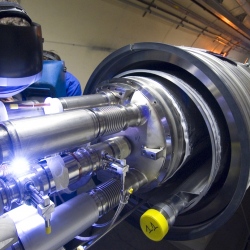
Particle physicists have been eagerly awaiting the first trials of the new Main Injector neutrino beam at the Fermi National Accelerator Laboratory in the US.
This new facility is the result of reconfiguration of the Fermilab particle accelerators in the wake of the shutdown of the Tevatron in 2011. The new beam source is now online, and is well on route to becoming the world’s most intense focused neutrino source.
A great deal of effort goes into studying neutrino physics and interactions, owing in large part to the indifference of neutrinos to the rest of the universe. Invisible to electromagnetic and strong interactions alike, a neutrino’s only known external influences are via the weak interaction and gravity. A very large number of very well behaved neutrinos are required to enable experiments to study the interaction of neutrinos with matter, neutrino oscillations, and neutrino mixing.
The main tools for such experiments are intense neutrino beams and enormous neutrino detectors. When a supernova was seen to explode in the Large Magellanic Cloud about 170,000 light-years distant, it grew to be easily visible with the naked eye, nearly outshining its galaxy. Even thought most of its energy was emitted in the form of neutrinos, scientists managed to detect just 24 neutrinos out of an estimated 1054 neutrinos.
So what’s required of a source of neutrinos for experiments? Most importantly, the source must supply a huge number of neutrinos to the experimental detectors so there is a signal to analyze. The only man made sources known to be suitable are large fission reactors and accelerator-driven neutrino beams.
The current and proposed experiments that appear to have the largest payoff in terms of possible new physics require a large distance between source and detector. For the Fermilab experiments, the detectors are in northern Minnesota, about 740 km (460 mi) distant) from the facility near Chicago.
When brought to full power, the Fermilab neutrino beam will have a current of about a trillion muon neutrinos per second, although these will be delivered as a one millisecond pulse emitted about every second. The angle of divergence of the beam is about 2 arcminutes, so that the beam will only expand to a diameter of about a kilometer at the neutrino detectors.
